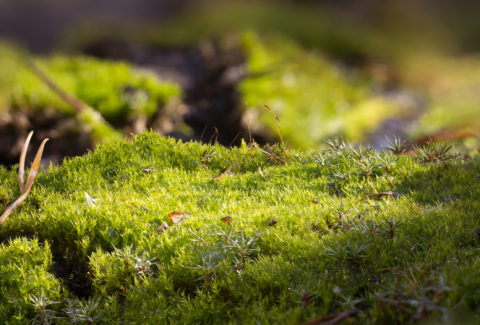
Moss looks good in the forest, perhaps not in your lawn. We can help you reduce moss problems.
The warm, sunny weather this week has made us think about spring and summer. It’s time to take a stroll around the landscape and see how your plants are doing as the growth season starts.
How does your lawn look? Has moss invaded after the tough winter?
Moss invades lawns when the grass does not have the right conditions to be healthy. If the lawn is healthy and in a location that favors grass, it can outcompete moss. Still, western Washington provides an ideal growing environment for moss, so you may not be able to banish it entirely.
Short-term action: Moss control
If you would like, we can apply a moss control treatment to your lawn. Iron is used to burn the moss, turning it black. Iron will dehydrate moss but will not kill it.
You will need to remove the moss with a thatching rake once it turns black. If it’s not raked out, it will come back more strongly. And if you don’t correct the conditions that favor moss, it will be a recurring problem.
Long-term solution: Improving lawn health

Would you like a healthier lawn with fewer weed and moss problems? We can help.
Since we started In Harmony 25 years ago, we have provided natural lawn care services. Our services focus on improving lawn health. Clients have told us that we have restored lawns that were thin, weedy and mossy and made them thick, green and lush.
If your lawn has underlying problems or it is in the wrong location, moss will grow better than grass will. We can help you address the root causes of moss problems.
Infertile. We fertilize our clients’ lawns with an organic fertilizer. It will feed the lawn slowly over time.
Acidic and/or low in calcium. We apply Dolopril lime as needed, which contains both calcium and magnesium.
Compacted. We are currently aerating lawns for our clients and and overseeding to fill in any thin spots. Contact us if you would like to get on our lawn care schedule.
Wet. If needed, we could fix drainage onto the lawn from the driveway or sidewalk. We could also alter the slope or fill in low spots that tend to stay wet. Contact us if you would like to discuss potential solutions to drainage issues.
Watering in summer can reduce moss problems
If you lawn gets too dry in summer, it can get thin and weak. As our summers get hotter and drier, lawns need some water to stay alive and healthy. Letting your lawn go dormant in summer can lead to moss problems in the fall when rains return. A lawn with bare, dead spots provides ideal conditions for moss and weeds to invade.
To help your lawn stay healthy, it needs about an inch of water per week. Water once or twice a week, not every day. And water slowly and deeply so the lawn develops deep roots. See more about smart lawn watering in this video.
Long-term solution for shady areas: grow a shade garden
Lawns are not shade plants. They grow best when they have regular sunlight. We can prune your trees to allow more sunlight to reach shady spots and to improve air circulation.
We don’t recommend removing trees for the sake of the lawn. We love trees, and as the earth warms up, we need more trees to cool our cities. Instead, we suggest working with one of our designers to create a shade garden where the lawn doesn’t grow well.
There are many beautiful plants that grow well in the shade and provide color, structure, texture and even fragrance. You can choose from shrubs, grasses, ferns and perennials.
You may want to consider adding a refuge in the shady area. In addition to plantings, you could add a small patio and a chair or two. Imagine sitting in the cool shade on a hot summer day with a book and a cool drink.
Your shady area could become a sanctuary for wildlife. Many native plants grow well in the shade. They attract native birds and wildlife. You could keep the area a bit wilder, with less pruning and more vegetation. Providing shelter encourages birds, bees and other wildlife to spend time in your yard.


Very nice article. Thanks for the information and your expertise while addressing a very common occurrence and frustration for homeowners.
Thanks for your comment. We’re glad you found the article useful.
Can you give me some pointers for thatching?
Or is there only One———a strong back
We will call you about this.